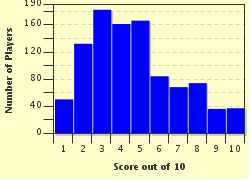Quiz Answer Key and Fun Facts
1. The toothsome beast shown here is native to the Indian subcontinent and is the only known surviving species of its taxonomic family. Like other Crocodylia it can grow quite large (the males of the species can reach a length of five meters), but its delicate jaw renders it incapable of eating large mammals. What is it?
2. This is a manta ray! Manta rays are quite large, reaching seven meters in length and weighing as much as 1,300 kilograms. As cartilaginous fish, rays are closely related to sharks. What dangerous type of ray is the gentle manta sometimes confused with?
3. Oh gross! Look at that! Is it a spider? Not a true one, although it does belong to the same class of Arachnidae. Is it a scorpion? No, it has only two tagmata. This is a solifugid! Solifugae are desert-dwelling arthropods and are known by many names. Which of the following is NOT a name given to the solifugid?
4. This furry little guy is a type of lemur native to Madagascar. With its reflective eyes it looks a little bit like something out of a nightmare, and in fact, to the Malagasy people, it is viewed as an omen of death if it is seen in a village. It is often killed on sight. Little wonder, then, that the species was once thought to be extinct. What is the common name for Daubentonia madagascariensis?
5. Archispirostreptus gigas is one big bug! It's one of the largest millipedes in the world, and can grow to almost 40 centimeters in length. A. gigas is a detritivore, eating mainly decaying plant matter in the wild. In captivity (that's right, people keep them as pets!) they can be fed on small pieces of soft fruits and vegetables. Which continent is home to this many-legged creature?
6. My goodness! Cover your mouth when you yawn! This shark can be found in boreal to temperate waters around the globe. Growing up to 12 meters in length, it is the second-largest species of fish in the world, and it is one of only three species of shark to feed on plankton. What kind of shark is shown here?
7. Awww! Isn't he a little darling? No, that's OK--you can keep him over there in his cage! This photograph is of a milk snake (Lampropeltis triangulum), a species of kingsnake native to the Americas. Milk snakes are not venomous; their main defence is in mimicry--colouration that is near to, or mimics, snakes which are more dangerous. Which venomous snake does the milk snake mimic?
8. Vultures have a very bad reputation, due to the ecological niche they fill as scavengers and carrion-eaters. The word "vulture" is a generic term applied to two groups of scavenging birds that evolved convergently on different parts of the globe (Wikipedia): the Old World vultures of Europe, Africa and Asia, and the New World vultures, or condors, of the Americas. As scavengers, vultures are rarely lethal (rather expected when your food has already conveniently been killed by something else), but they are viewed as harbingers of death. As an Old World vulture, what sense does the griffon vulture (Gyps fulvus) rely on to find a tasty carcass?
9. Pictured here (though I rather wish it wasn't!) is, by mass, the largest spider in the world. Theraphosa blondi can grow up to 170 grams with a legspan reaching 30 centimeters. Arachniphobia--fear of spiders--is often listed as one of the most common phobias to afflict mankind, and just taking a look at T. blondi over there it's easy to see why. However, this species of tarantula, though large, is far from lethal to humans. The venom in its bite is no worse than a sting from a wasp. From which biblical warrior does T. blondi derive its common name?
10. Say hello to Desmodus rotundus, the common vampire bat. Vampires are folkloric beings who are known for feeding from the blood of the living, which is a trait shared by D. rotundus. Vampire bats feed mostly on mammals, including humans, but their bites are not generally considered dangerous to human health. Which of the following words describes the specialized diet of D. rotunda?
Source: Author
LadyCaitriona
This quiz was reviewed by FunTrivia editor
Tizzabelle before going online.
Any errors found in FunTrivia content are routinely corrected through our feedback system.


